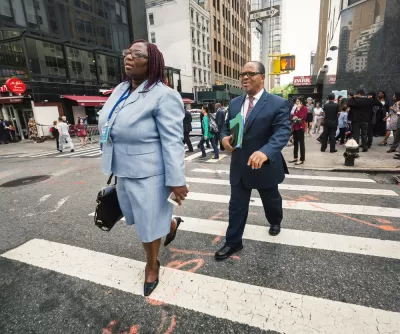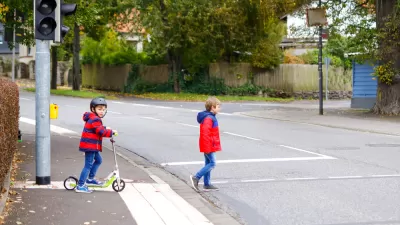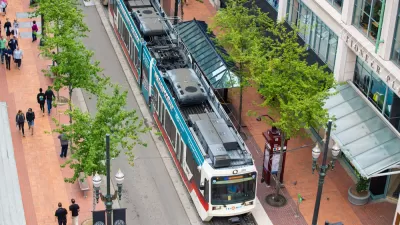The majority of pedestrian master plans consider how to make equitable walking infrastructure. Less than half of plans implement strategies to address the fact that people of color are disproportionately represented in pedestrian fatalities.

Amber Berg and Gregory Newmark's new paper "Incorporating Equity into Pedestrian Master Plans" analyzes 15 pedestrian master plans from major American cities "to understand how some of the largest departments of transportation were — or weren’t — centering the needs of marginalized communities in their policies," writes Kea Wilson.
Wilson points to a troubling finding from Smart Growth America that older, non-white pedestrians are disproportionately more likely to be killed by drivers than white pedestrians. Wilson describes the paper's analysis:
But Berg and Newmark found that even cities with more "vertical" approaches to equity planning were not necessarily reducing disparities in their equity metrics. To understand why, they evaluated all the plans through a framework they are calling the “Three A’s”: Acknowledgment, Accountability, and Application.
Measuring equity in pedestrian plans using these three metrics, Berg and Newmark found that Portland and Seattle lead the pack. "These seemingly subtle differences, the researchers say, can have huge implications for a region’s long-term equity efforts," writes Wilson.
FULL STORY: Why Every City Needs to Learn the Three A’s of Equitable Pedestrian Planning

Alabama: Trump Terminates Settlements for Black Communities Harmed By Raw Sewage
Trump deemed the landmark civil rights agreement “illegal DEI and environmental justice policy.”

Planetizen Federal Action Tracker
A weekly monitor of how Trump’s orders and actions are impacting planners and planning in America.

The 120 Year Old Tiny Home Villages That Sheltered San Francisco’s Earthquake Refugees
More than a century ago, San Francisco mobilized to house thousands of residents displaced by the 1906 earthquake. Could their strategy offer a model for the present?

In Both Crashes and Crime, Public Transportation is Far Safer than Driving
Contrary to popular assumptions, public transportation has far lower crash and crime rates than automobile travel. For safer communities, improve and encourage transit travel.

Report: Zoning Reforms Should Complement Nashville’s Ambitious Transit Plan
Without reform, restrictive zoning codes will limit the impact of the city’s planned transit expansion and could exclude some of the residents who depend on transit the most.

Judge Orders Release of Frozen IRA, IIJA Funding
The decision is a victory for environmental groups who charged that freezing funds for critical infrastructure and disaster response programs caused “real and irreparable harm” to communities.
Urban Design for Planners 1: Software Tools
This six-course series explores essential urban design concepts using open source software and equips planners with the tools they need to participate fully in the urban design process.
Planning for Universal Design
Learn the tools for implementing Universal Design in planning regulations.
Clanton & Associates, Inc.
Jessamine County Fiscal Court
Institute for Housing and Urban Development Studies (IHS)
City of Grandview
Harvard GSD Executive Education
Toledo-Lucas County Plan Commissions
Salt Lake City
NYU Wagner Graduate School of Public Service





























